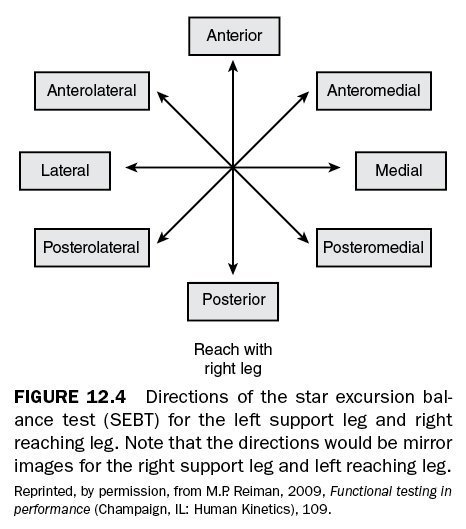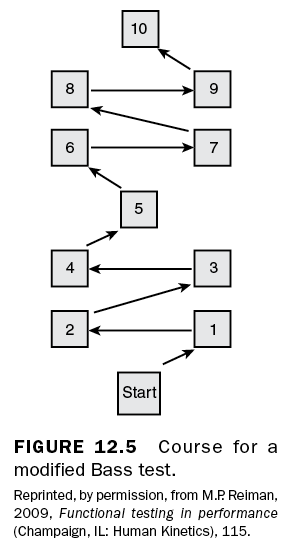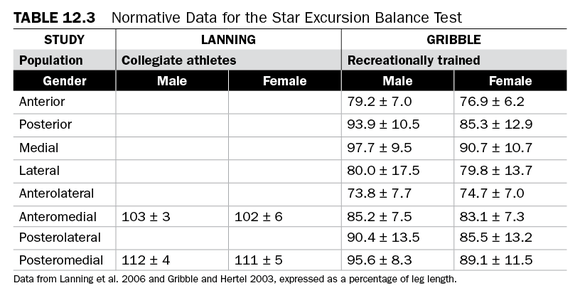Measuring Balance and Stability
Fitness professionals should first establish the purpose of the test, pick a category that would fulfill that purpose, and then select a test based on the level of precision required and the resources available. Three tests, the balance error scoring system (BESS), the star excursion balance test (SEBT), and the modified Bass test, were selected for detailed discussion here because they represent different categories (postural steadiness, reach, and postural stability) and require minimal specialized equipment. Additionally, the BESS and SEBT have excellent reliability and a large body of literature supporting them. Interested readers should consult the original literature cited in the reference section for detailed procedures on conducting the other tests. Table 12.1 compares balance and stability evaluations.

Balance Error Scoring System (BESS)
Equipment
A foam balance pad. The foam pad is one piece of medium-density foam (45 cm2× 13 cm thick, density 60 kg/m3, load deflection 80-90).
Procedure
The six positions of the balance error scoring system test are depicted in figure 12.3. Three stances (double-leg support, single-leg support, and tandem) are held for 20 seconds on two surfaces (firm floor and foam pad) for six permutations (Riemann, Guskiewicz, and Shields 1999). During the tandem stance, the dominant foot is in front of the nondominant foot. During the single-leg stance, the subject stands on the nondominant foot. During the test, the eyes are closed and the hands are held on the hips (iliac crests).
Subjects are told to keep as steady as possible, and if they lose their balance, they are to try to regain the initial position as quickly as possible. Subjects are assessed one point for the following errors: lifting the hands off the iliac crests; opening the eyes; stepping, stumbling, or falling; remaining out of the test position for five seconds; moving the hip into more than 30° of hip flexion or abduction; or lifting the forefoot or heel (Riemann, Guskiewicz, and Shields 1999). A trial is considered incomplete if the subject cannot hold the position without error for at least five seconds. The maximal number of errors per condition is 10. An incomplete condition is given the maximal number of points (10). The numbers of errors for all six conditions are summed into a single score.
Star Excursion Balance Test (SEBT)

Equipment
Athletic or masking tape
Procedure
The SEBT requires the floor to be marked with a star pattern in eight directions, 45° apart from each other: anterior, posterior, medial, lateral, posterolateral, posteromedial, anterolateral, and anteromedial (see figure 12.4). One foot is placed in the middle of the star pattern. The subject is instructed to reach as far as possible, sequentially (either clockwise or counter clockwise), in all eight directions.
The directions are not labeled consistently in the literature. For example, when balancing on the left leg and reaching to the right with the right leg, some authors call this direction medial (Gribble and Hertel 2003; Hertel et al. 2006), whereas others call it lateral (Bressel et al. 2007). This text adopts the convention that, when standing on the left leg, reaching to the right of the left leg is in the medial direction, whereas reaching to the left (and behind the stance leg) is in the lateral direction (see figure 12.4).
The subject makes a light tap on the floor, and then returns the leg to the center of the star. The distance from the center of the star to the tap is measured. The trial is nullified and has to be repeated if the subject commits any of the following errors: makes a heavy touch, rests the foot on the ground, loses balance, or cannot return to the starting position under control (Gribble 2003). The starting direction and support leg are chosen randomly. Three trials are performed and then averaged.
Because of the significant correlation between SEBT and leg length (.02 ≤ r2≤ .23) in a majority of the directions, excursion values should be normalized to leg length, measured from the ASIS to the medial malleolus (Gribble and Hertel 2003). Additionally, Hertel and colleagues (2006) suggested that testing in eight directions is redundant, and that testing only the posteromedial direction is sufficient for most situations. To decrease the effect of learning, Kinzey and Armstrong (1998) suggested that subjects be given at least six practice trials before being tested, although other authors suggested reducing the number of practice trials to four (Robinson and Gribble 2008).
Modified Bass Test

Equipment
Athletic or masking tape
Procedure
This multiple hop test requires that 1-inch (2.5 cm) tape squares be laid out in a course as shown in figure 12.5 (Riemann, Caggiano, and Lephart 1999). The subject is required to jump from square to square, in numbered sequence, using only one leg. The hands should remain on the hips. On landing, the subject remains looking facing straight ahead, without moving the support leg, for five seconds before jumping to the next square.
There are two types of errors: landing errors and balance errors. A landing error occurs if the subject’s foot does not cover the tape, if the foot is not facing forward, if the subject stumbles on landing, or if the subject takes the hands off the hips. A balance error occurs if the subject takes the hands off the hips or if the nontesting leg touches down, touches the opposite leg, or moves into excessive flexion, extension, or abduction. The subjects may look at the next square before jumping to it.
The examiner should count aloud the five seconds the subject is to maintain the position before moving to the next square. At the conclusion of the test, 10 points are given for each five-second period in which there was a landing error and 3 points for each period in which there was a balance error. The sum of the two is the total score. At least two practice sessions should be given before testing for score.
Interpreting the Results
When interpreting the results of balance or stability tests,values can be compared to normative data, the other leg (if performed on a single leg), or the same person over time. Normative data are presented for the BESS, SEBT, and modified Bass in tables 12.2 through 12.4, respectively. Currently, no data exist to suggest either a cutoff score for these tests or, in the case of the SEBT or modified Bass test, a bilateral difference that would be a cause for concern. These are areas for future investigations. Balance scores tend to be better in the morning than in the afternoon or evening (Gribble, Tucker, and White 2007), suggesting that if multiple tests are to be compared over time, the time of day needs to be standardized.


